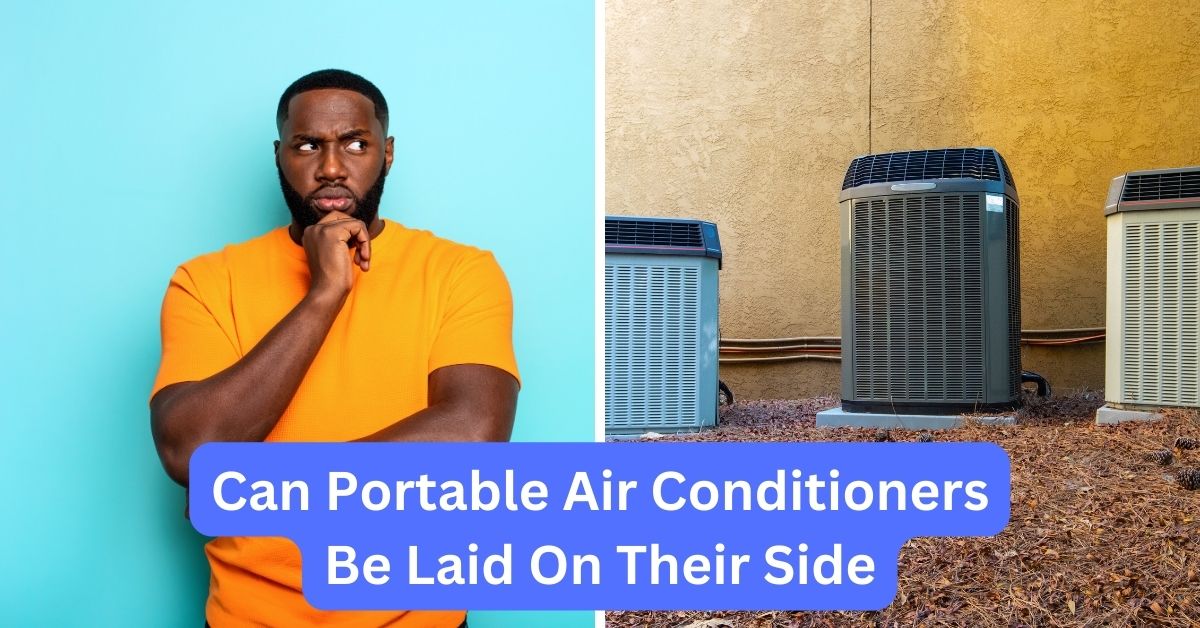Can Portable Air Conditioners Be Laid On Their Side? A Guide To Proper Usage
No, portable air conditioners should not be laid on their side. This is because the compressor and other components inside the unit are designed to function properly when the air conditioner is upright. Laying it on its side can damage the unit and affect its performance.

Are you a homeowner, apartment renter, or small business owner who relies on a portable air conditioner to keep your space cool and comfortable? If so, you’ve likely wondered whether it is safe to lay your portable air conditioner on its side. Finding clear guidance on this topic can be frustrating, with conflicting information leaving you unsure of the proper procedure.
The last thing you want is to damage your appliance or compromise its cooling capabilities. In this blog article, we will delve into the question: can portable air conditioners be laid on their side? We’ll provide you with expert advice and guidance to help you make an informed decision.
Whether you’re a seasoned portable air conditioner user looking for clarity or someone considering purchasing one for the first time, this article is for you. Throughout the article, we will explore the potential risks and benefits of laying a portable air conditioner on its side. We’ll discuss the various factors you should consider, including the type of unit you have and the manufacturer’s recommendations.
Additionally, we’ll address commonly asked questions and provide practical tips to ensure the longevity and effectiveness of your portable air conditioner. By the end of this article, you’ll have a comprehensive understanding of whether laying a portable air conditioner on its side is safe and the potential implications it may have on its performance. Say goodbye to the confusion and uncertainty surrounding this topic, and gain the knowledge you need to optimize your cooling solution.
Understanding the Risks
If you’re considering laying your portable air conditioner on its side, it’s important to understand the potential risks involved. While some units may be designed to accommodate this positioning, it’s not always the case.
Type of Unit
The first factor to consider is the type of portable air conditioner you own. There are two main types: single-hose and dual-hose units. Single-hose units have one hose that exhausts hot air outside and pulls in fresh air from the room. Dual-hose units, on the other hand, have an additional hose that pulls in air from outside to cool the condenser and then exhausts the hot air back outside.
Single-hose units are generally more portable and easier to install, but they tend to be less efficient. Dual-hose units, while slightly more complex to set up, offer improved cooling performance. It’s important to know which type of unit you have, as their construction and design can affect their ability to be laid on their side.
Manufacturer’s Recommendations
Another crucial aspect to consider is the manufacturer’s recommendations. Portable air conditioner manufacturers often provide specific guidelines on how to use and position their units for optimal performance and longevity. These recommendations can vary from brand to brand and even between different models.
Before contemplating laying your portable air conditioner on its side, refer to the user manual or the manufacturer’s website to check if they explicitly state whether it is allowed or not. These guidelines are typically developed based on the unit’s design, internal components, and cooling mechanism.
Benefits of Laying a Portable Air Conditioner on Its Side
While there are risks associated with laying a portable air conditioner on its side, there are also potential benefits in certain situations. Let’s explore some of these advantages:
Space-Saving Solution
One significant benefit of laying a portable air conditioner on its side is the space-saving advantage it offers. In some living situations, space may be limited, and positioning the unit vertically may not be feasible. By laying the unit on its side, you can place it under a bed, on a shelf, or in another tight space without sacrificing cooling performance.
Improved Airflow
In certain cases, laying a portable air conditioner on its side can enhance airflow and cooling efficiency. This is particularly true for units equipped with a dual-hose system. By positioning the unit horizontally, you may be able to optimize air circulation and allow the hoses to function more effectively.
However, it’s important to note that not all portable air conditioners will benefit from this positioning. It is crucial to consider the specific design and features of your unit before deciding to lay it on its side.
Potential Risks and Drawbacks
While there are potential benefits to laying a portable air conditioner on its side, it’s crucial to be aware of the potential risks and drawbacks involved. Here are some factors to consider:
Compressor Damage
The compressor is an essential component of a portable air conditioner. It is responsible for compressing the refrigerant and initiating the cooling process. When a portable air conditioner is laid on its side, there is a risk that the oil inside the compressor may leak into other parts of the unit. This can cause damage to the compressor and result in diminished cooling performance or complete system failure.
To minimize the risk of compressor damage, it’s crucial to refer to the manufacturer’s recommendations. If they explicitly state that the unit should not be laid on its side, it’s best to follow their guidelines to protect the longevity and effectiveness of your portable air conditioner.
Drainage Issues
Another potential drawback of laying a portable air conditioner on its side is drainage issues. Most portable air conditioners extract moisture from the air as they cool, and this moisture is typically collected in a reservoir or drained through a hose. When the unit is positioned horizontally, the drainage system may not function properly, leading to water leakage or accumulation inside the unit.
If you do decide to lay your portable air conditioner on its side, it’s crucial to ensure that the drainage system is not compromised and that the water can flow freely without causing any issues.
Practical Tips for Optimizing Performance
If you determine that laying your portable air conditioner on its side is the best option for your specific situation, here are some practical tips to optimize its performance and minimize potential risks:
Check the User Manual
Always refer to the user manual or the manufacturer’s guidelines for your specific model. They will provide you with detailed instructions on how to safely and effectively position your portable air conditioner.
Protect the Compressor
If you decide to lay your portable air conditioner on its side and the user manual allows it, take extra precautions to protect the compressor. Place the unit on a stable and level surface to prevent any tipping or damage to internal components.
Monitor Drainage
Ensure that the drainage system is functioning correctly and that water is not accumulating inside the unit. Regularly check the reservoir or drainage hose to prevent any issues that may arise from improper drainage.
Perform Regular Maintenance
Regardless of how you position your portable air conditioner, regular maintenance is essential to ensure optimal performance. Clean or replace the air filters as recommended by the manufacturer, and keep the unit free from dust and debris.
Consider Alternative Cooling Solutions
If laying your portable air conditioner on its side poses too many risks or limitations, consider alternative cooling solutions. There are various portable air conditioning units available that are designed to be positioned vertically or mounted on a window, providing efficient cooling without the need to lay them on their side.
So, can portable air conditioners be laid on their side? The answer depends on several factors, including the type of unit you have and the manufacturer’s recommendations. While laying a portable air conditioner on its side may offer space-saving advantages and improved airflow in certain cases, it also poses risks such as compressor damage and drainage issues.
It’s crucial to carefully consider the specific details and guidelines provided by the manufacturer before making a decision. By following their instructions and implementing the practical tips we’ve discussed, you can make informed choices to optimize the performance and longevity of your portable air conditioner.
Remember, when it comes to your portable air conditioner, it’s always better to prioritize safety and effectiveness over convenience.
What happens if you lay a portable air conditioner on its side?
Frequently Asked Questions (FAQ)
Can portable air conditioners be laid on their side?
Will laying a portable air conditioner on its side affect its cooling ability?
Can a portable air conditioner be transported while laying on its side?
What are the potential risks of laying a portable air conditioner on its side?
Can a portable air conditioner be installed sideways?
Final Words: Considerations and Alternatives for Laying Portable Air Conditioners on their Side
In conclusion, while it may be tempting to lay a portable air conditioner on its side for space-saving or improved airflow purposes, there are potential risks and drawbacks to consider. The type of unit and the manufacturer’s recommendations play a crucial role in determining whether it is safe and advisable to lay the unit on its side.
The risks associated with laying a portable air conditioner on its side include potential compressor damage and drainage issues. Compressor damage can occur due to oil leakage, which can lead to diminished cooling performance or system failure.
Drainage issues may arise when the unit is positioned horizontally, causing water leakage or accumulation inside the unit. To optimize the performance and minimize risks, it is essential to follow the manufacturer’s guidelines and take necessary precautions. Checking the user manual, protecting the compressor, monitoring drainage, and performing regular maintenance are practical tips to ensure proper functioning of the unit.
If the risks and limitations of laying a portable air conditioner on its side outweigh the benefits, alternative cooling solutions should be considered. There are portable air conditioning units available that are designed to be positioned vertically or mounted on a window, providing efficient cooling without the need to lay them on their side. In conclusion, the question of whether portable air conditioners can be laid on their side depends on various factors.






